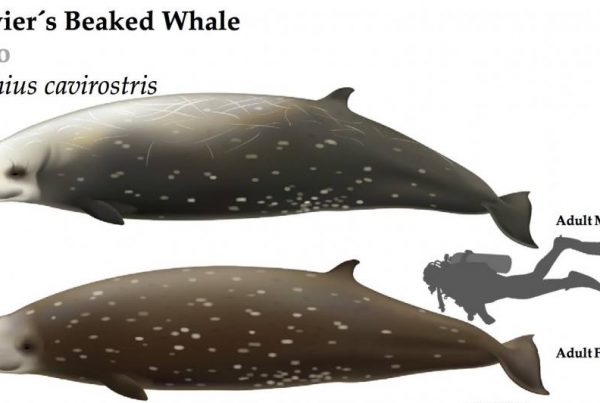
Northern Bottlenose Whales, Hyperoodon ampullatus, are endemic to the North Atlantic Ocean and have an estimated population of at least 10 000 individuals. They are the largest beaked whales that can be spotted in Azores.

Northern Bottlenose Whale spy-hopping. Photo credit: Pierre Jaquet.
CHARACTERISTICS
- Latin name : Hyperoodon ampullatus
- Suborder : Odotonceti
- Family: Ziphiidae
- Length : up to 10 meters
- Weight : up to 3.6 tons
- Dive time : up to 120 minutes
- Dive depth: up to 1 400 meters
- IUCN Status: Data deficient

Worldwide distribution of Northern and Southern Bottlenose Whale (Hyperoodon spp.). Encyclopedia of Marine Mammals IIIrd Ed. Bernd Würsig, I. G. M. Thewissen & KIT M. Kovacs
DESCRIPTION
Color: Dark-brown Back, and slightly paler belly. Usually old males have a white patch on their head.
Head: pronounced sexual dimorphism: small melon and uniform color (female); distinctive bulbous melon and white patch on the head (male).
Fins: Falciform dorsal fin on the two-thirds of the back.
Teeth: One pair of teeth at the tip of the lower jaw (mature male).
LIFE HISTORY
DIET
Northern Bottlenose Whale mainly feed on squid, but also on small fish and benthic organisms.
REPRODUCTION
Sexual maturity is reached at the age of 8-14 years (female) and 7-9 years old (male).The gestation lasts about 12 months. Females usually give birth every 2-3 years. At birth, calves measure around 3 meters in length. Mating and calving occurs in April-Juin.
SOCIAL BEHAVIOR
They are usually in pod of 4-10 individuals. Northern Bottlenose Whales live in mixed age groups during the reproductive season. Scarring is typical, especially on males, due to social aggressive behavior.

Northern Bottlenose Whale adult males pod. Photo credit: Andreas Maeker.
VOCAL BEHAVIOR
The Northern Bottlenose Whales’ communication behavior seem restricted to high frequencies whistles (24 kHertz) and echolocation clicks. You can listen to their calls in this recording from Canadian waters.


















Your thoughts on this?